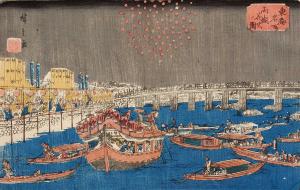Famous Places in the Eastern Capital: Ryōgoku Fireworks (Tōto Meisho Ryōgoku Hanabi no Zu)
Painted by Utagawa Hiroshige I Around the end of the Tempō period (1830-1844) Tokyo Shiryō Collection 0421-C93
Every year on May 28, together with River Opening of Ōkawa (Sumida river), a grand firework display was held. A large number of sightseers would flock to watch the fireworks from the Nōryō ships which floated along the river, and from the Ryōgoku Bridge.
This is the Ryogoku Grand Firework Display which lends flair to summertime in Sumida River. It is possible to trace the beginnings of this to 1733 (18th year of Kyoho). The eighth Shogun Yoshimune organized the festival of water deity and the Segaki-e service (a mass for the repose of the dead) in Ryogoku in order to commemorate those who had died in the famine the previous year and to offer supplication against diseases. It is said that the firework display and the river festival that were held at this time mark the origin of this event.
Many summer pleasure boats and roofed pleasure boats are depicted floating on Sumida River on the picture. Whilst it is possible to see the fireworks from roofed pleasure boats even today, passing the time with boats was a luxurious pastime that was only possible for wealthy warriors and merchants. It is likely that many people would have been watching them enviously from the river bank.
Regardless of rich or poor, the Ryogoku fireworks that can be viewed from anywhere free of charge draw in large crowds, both then and now, and it may be said that they are the essence of an Edo summer.


